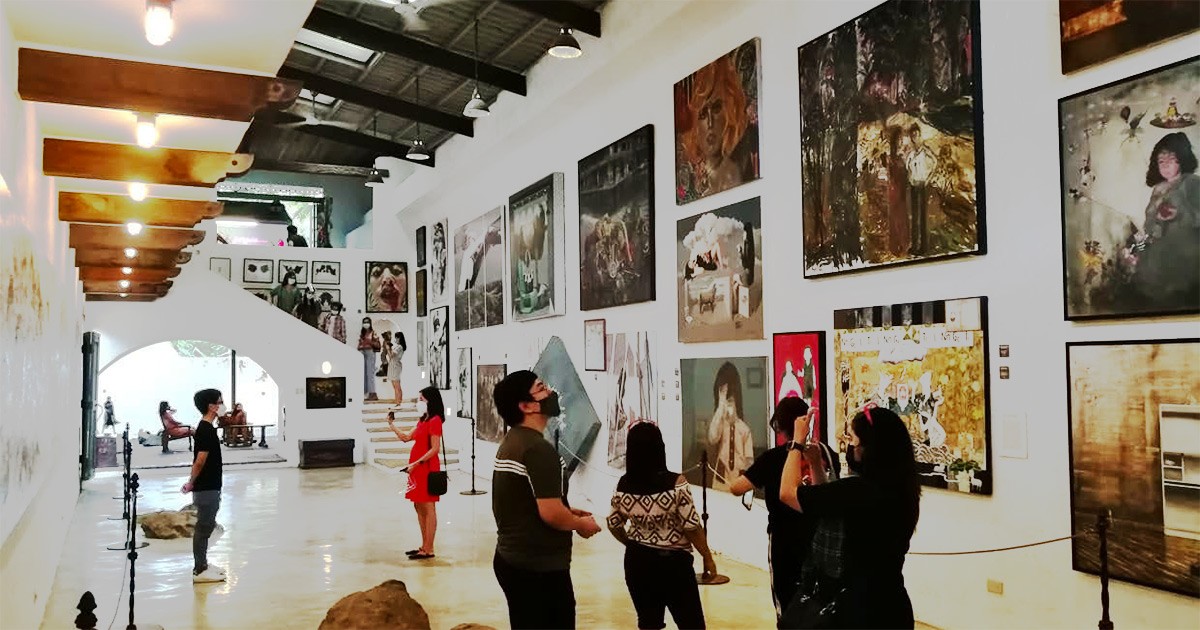
Pinoy Creatives celebrate newly-adopted Creative Industries Development Act
By CREATEPhilippines
August 02, 2022
Pangasinan 4th District Rep. Christopher ‘Toff’ de Venecia welcomes the timely enactment of the Creative Industries Development Act on the second day of the Creative Futures 2022 digital conference attended by over 2,000 participants from 32 countries. Now in his second term as Chairman of the Special Committee and Performing Arts in the House of Representatives, De Venecia announced that this is “a big, essential, and existential leap” made possible through the collective push of public and private sectors and creative domains.
Through its flagship event Creative Futures, DTI-CITEM’s CREATEPhilippines cultivates an enabling environment for the creative ecosystem to learn, network, and seize opportunities in the Philippines and beyond. Returning this year as a speaker, De Venecia focused on the next steps and priorities following the passage of the Creative Industries Development Act.
De Venecia is hopeful that the Creative Industries Development Act, or Republic Act 11904, will be prioritized for immediate implementation and shall receive significant funding in the 2023 budget following President Bongbong Marcos' first State of the Nation Address last Monday, July 25. However, De Venecia also acknowledged that there is still much to be done to bring the law up to speed with the international creative market.
“The passage of the Philippine Creative Industries Development Act, while a watershed moment in our creative history, is our country playing catch-up to a creative future that is being enjoyed as a creative present by many of our neighbors in ASEAN and around the globe… We are finally investing in Filipino talent that we have long taken for granted or left to their own devices,” De Venecia said.
One of the objectives De Venecia highlighted is forging a well-articulated education system that fosters creativity and innovation. According to De Venecia, this can be achieved by building closer links between the academe and industry to avoid job-skills mismatch, supporting creative educators, and incentivizing academic institutions.
The Creative Industries Development Act will also uphold workers’ rights by institutionalizing Creative Workers Welfare as a Standing Committee attached to the Creative Industries Development Council. Because the majority of Filipino creative workers are freelancers, De Venecia said that the Creative Industries Development Act will be complemented by Freelance Workers Protection Bill. He also stressed the need to update the current intellectual property law, noting the widespread online piracy in the digital age.
Building a creative powerhouse
In an opening speech in Creative Futures 2022, DTI Secretary Alfredo E. Pascual emphasized DTI’s goal of elevating the Philippine creative economy and increasing its competitiveness globally. He reiterated the agency’s vision of transforming the Philippine creative economy into the top among ASEAN countries by 2030 in terms of the size and value of the creative industries, as envisioned by the Creative Economy Roadmap submitted by the Creative Economy Council of the Philippines (CECP).
“We are reclaiming our path to development. As the world approaches the Fourth Industrial Revolution, we are marching forward to the global stage and going above and beyond in support of the digitalization of creative industries,” said Pascual.
Pascual also mentioned some of DTI’s policy recommendations in support of this mission such as making creativity a national priority, promoting creative hubs and clusters, and advocating for the development of Philippine Creative Cities.
Assistant Secretary Glenn Peñaranda, Officer-in-Charge for DTI’s Trade Promotions Group (TPG), underlined the economic potential of the Philippine creative industries. Peñaranda also shared some of TPG’s existing initiatives for the creative industry including various training, capacity-building, export assistance programs, and market access platforms.
Peñaranda also highlighted opportunities for the creative sector as freelancing becomes mainstream. Citing the Creative Economy Council of the Philippines (CECP), Peñaranda said that there are approximately 2 to 3 million creative freelancers working locally, while 1.5 million creatives handle international projects.
“While the Philippines is considered to be the top exporter of creative services in the ASEAN region, our total creative exports only amount to 2% market share in Asia-Pacific. This presents ample room for growth and an opportunity for us to invest especially in IP-based creative goods and services,” Peñaranda said.
Talking business with creatives
Creative Futures 2022 started with a presentation by ShootPH, a production service company. ShootPH founders Steve Vesagas, Chris Thorp, Steven Marolho illustrated the current advertising landscape, focusing on the potential of the Philippines to compete against market leaders such as Thailand, Malaysia, and Vietnam. According to Morolho, foreign film production revenues from short-form content alone reach $40 million in Thailand.
“The Philippines is already well-placed to support and service the growth of remote production, especially with the ease of communications in English. With access to bigger international projects, the Philippine crews will grow their skillset and the overall platform will be enhanced, positioning it as a production hub go-to,” said Chris Thorp.
The two-day online conference spotlighted some of the largest creative sectors in the country such as film, game development, and esports. The event also made room for creative segments that have the potential to make it big with appropriate institutional support, such as type design.
According to analyst firm Newzoo, the global video game market is estimated at $180 billion in 2021, generating more revenue than the movie and music industries combined. In the Philippines, Statista data reveals that the online games market generated around $24 million in revenue in 2020, an increase of 27.9% compared to 2019.
“The game development industry and animation industry grew exponentially during the pandemic, and it’s something we can capitalize on,” said James Lo, President of the Game Developers Association of the Philippines.
The same thing happened with the esports sector. Ariane Lim of AcadArena emphasized that esports is not just a fleeting trend but a paradigm shift that is currently happening. Lim also shared opportunities in the industry as location matters less in esports and Filipinos can be paid international rates early on in their careers.
“Esports and gaming can be great equalizers because they are global trends. These are readily accessible anywhere in the world. Our mastery of the English language gives us a competitive advantage in Southeast Asia,” Lim said.
Aside from esports, the growing local film industry was also spotlighted during the conference. In a documentary, filmmaker Martika Ramirez Escobar reflected on the Sundance participation of her award-winning film “Leonor Will Never Die.” Escobar recounted how she and her team were forced to join the festival virtually due to the pandemic. According to the Cinema Exhibitors Association of the Philippines (CEAP), the film industry incurred an estimated P21 billion in losses due to lockdowns and mobility restrictions.
Producer Monster Jimenez also shed light on struggles that filmmakers face particularly regarding distribution. Jimenez said local films like “Leonor Will Never Die” find it difficult to compete with foreign commercial films that dominate mall cinemas.
“In every screening, any play date, there’s only a maximum of two Filipino films per every 12 films on a slate that’s now showing… If you’re going to do that, then give us more time. Like in Indonesia, the average number of weeks an Indonesian film, or any film, shows is 8 weeks,” Jimenez said.
In another panel discussion, singer and composer juan karlos and industry experts tackled the contentious issue of IP rights and possible new business models for musicians, particularly amid emerging technologies such as blockchain and metaverse.
“A lot of artists don't know much about these kinds of things. It's hard to take action if you don't have information. What I would like to see more is educating all of these artists that are already in the industry or even before they get into the industry. How does the industry work? What are your rights? It's really information, that's the main thing that's missing now,” said juan karlos.
Teodor Pascua of the Intellectual Property (IP) Office of the Philippines (IPOPHL) highlighted government efforts to protect intellectual property, citing proposed amendments to the code.
Ron Hose, founder of Coins.ph, offered insight on how new technologies like blockchain aid artists. “It [Blockchain] promises to allow creators to have more control and long-term ability to earn from the work that they produce. Today, it is an ecosystem where there are many intermediaries in the middle taking value between consumer and producer. But as these new tools and technology mature, musicians should pay attention and the music industry should hop on board,” said Hose.
Meanwhile, Jo Malinis of Type63, an online registry and catalog of Philippine typefaces, discussed the commercial and artistic viability of type design. Malinis explained how type design can provide opportunities for creatives despite being a fairly new creative sector in the Philippines, citing the widely-used font Quicksand by Andrew Paglinawan and Alli Cunanan’s Ladybird which has been used in the promotional material of popular K-pop stars.
“Filipino type is an unexplored design landscape with vast economic and artistic potential. The goal is for our industry to get the recognition and support it so deserves,” Malinis said.
Creative Futures 2022 featured 40 local and international speakers and 20 multi-industry discussions including Pasig City Mayor Vico Sotto, Alao Design’s Arch. Aya Maceda, and designers Kristian Henson and Monica Ramos’ presentation on how design can renew public spaces. Other experts and thought leaders who also presented at the conference include Fifth Wall Fest’s Madge Reyes, Museo Pambata Executive Director Micah Pinto, Director Joel Ferrer, Asian Consulting Group Chairman Mon Abrea, Youtube Philippines’ Partnership Head Siddharth Srinivasan, and Atty. Jeremy Bayaras of IPOPHL.
Global Filipino Creatives discussed the business of being a creative in a series of interviews with chef Tom Cunanan, LVMH Prize semi-finalist Anthony Alvarez Graff, Tony and Grammy-award winning producer Jhett Tolentino, New York Times bestselling author Jenny Odell, session musician Tina Hizon, food writer Bettina Makalintal, creative director and chef Angela Dimayuga, independent curator and museum professional PJ Policarpio, New York Times Opinion Desk Design Director Kate Elazegui, and Angelo Cuyegkeng of Canva Philippines.
The Department of Tourism’s (DoT) ASMR series and photographer Jake Verzosa’s Across the Archipelago: The Pan-Philippine Highway were also streamed throughout the event.
Creative Futures 2022 is organized by DTI-CITEM in partnership with the Tourism Promotions Board (TPB), IPOPHL, and Youtube.
Creative Futures session replays are available on Hopin until August 5, 2022, and will soon be available on CREATEPhilippines.
About CITEM
The Center for International Trade Expositions and Missions (CITEM) is the export promotions arm of the Philippine Department of Trade and Industry (DTI).
For nearly 40 years, CITEM has established the country’s image as a premier destination for quality export products and services. It continues to set the highest standards of creativity, excellence and innovation to achieve competitiveness in the home, fashion, lifestyle, food, creative, and sustainability sectors.
CITEM is committed to developing, nurturing, and promoting micro, small, and medium enterprises (MSMEs), brands, designers, and manufacturers by implementing an integrated approach to export marketing in partnership with other government and private entities.
About CREATEPhilippines
CREATEPhilippines is the country’s flagship trade promotions program that showcases the Philippines' creative industries as a high-potential export sector and driver of economic growth.
It brings together the creative industries and champions local talent by organizing events that create an enabling environment for the creative ecosystem to learn, network, and seize opportunities in the Philippines and beyond.
As a content and community platform, it promotes the creative industries and its products and services. It also offers a database to help Filipino creatives become searchable to a global audience looking for talent.
CREATEPhilippines is led by the Center for International Trade Expositions and Missions (CITEM).
Ref. Elmer Harold Grande
Email: [email protected]
Twitter: @createPHILS
Instagram: @createphilippines
Facebook: @createphilippines



